| |

IN THE SHADOW
OF THE DOWNS
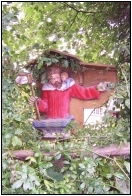 |
|
Many
years ago, long before I came to live in
Petersfield, I had a book called The
Countryside Companion, which contained a
photograph of a roadside statue of St.
Christopher above the caption Treyford,
Sussex.
Such
waymarkers are unusual in this country
and are more commonly found in south
Germany. According to the Golden Legend
Offero was a man of colossal stature, who
helped travellers across a river. One day
he carried a little boy, whose weight was
more than the giant could bear,
eventually revealing himself as the
Christ Child, who carried the weight of
the world on his shoulders. So Offero was
known as Christopher, and became the
patron saint of travellers, although he
is no longer recognised as such by the
Catholic Church. |
I recalled this
picture years later when I came to Petersfield,
and duly found the signpost at Treyford, where it
remains to this day, It was designed by Graily
Hewitt, a distinguished calligrapher who lived
nearby, and apparently it disappeared for some
years, turning up in Essex before being returned
to its original place.
Treyford is one of a series of villages nestling
below the South Downs between Harting and
Cocking. The walk along the ridge is
exhilarating, but for the less energetic the
narrow road through the villages of Elsted,
Treyford, Didling and Bepton is no less
rewarding, with magnificent views of the Downs,
bare and wooded in turn, along the whole route.
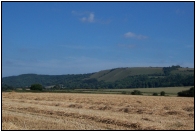 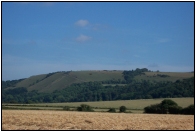
A
mile or so east of South Harting, Elsted is the
most compact of these villages, although the
original parish was huge, even incorporating
Hooksway on the other side of the Downs. It still
retains three pubs: the Three Horseshoes, now a
well-known food pub, but for many years run by
Dick Tullett and his wife Winnie, whose parents
had the pub before them. It was greatly beloved
of Hillaire Belloc and the topographer E.V.
Lucas. Forty years ago we used to sing carols
there at Christmas, arriving on a tractor-drawn
wagon. The Elsted Inn, just down the road, was
formerly the Station Inn, built beside the
Petersfield to Midhurst branch line, which opened
in 1864, and for ninety years was the
locals’ best link with either town.
The third, far away across the Downs, is the
Royal Oak at Hooksway, hidden below the road from
Petersfield to Chichester. Here the legendary Alf
Ainger was landlord for sixty years until his
death soon after 1970. He was a celebrated folk
singer and story teller, but was profoundly deaf,
and it was difficult to carry out a conversation
with him. Details of how his brothers and sisters
died in the great freeze of 1880 and how his
father left London to become lock-keeper on the
Chichester canal varied from time to time, but
his reply to the question “Where’s the
loo?” never changed. “There’s
acres of grass out there,” he always said,
pointing to the nearby Downs, causing amusement
or embarrassment in equal measure.
Treyford has two churches, both completely
ruined. The old church was deserted when the
large cathedral-like St. Peter’s was built
in 1849, serving Treyford-cum-Didling and Elsted,
but this in turn became unsafe and was blown up
in 1951, leaving a big burial ground, the centre
of the parish moving to Elsted, whose own
charming Saxon church was restored. On the hill
behind Treyford stands a memorial to Hauptmann
Joseph Oestermann, the pilot of a German aircraft
disabled during a raid on Aldershot. He remained
at the controls, enabling his crew to bail out,
before crashing into the hillside.
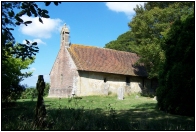 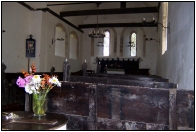
Didling,
a couple of miles further on, is unique, its
little church situated on the actual slope of the
Downs, described by Ian Nairn in the Sussex
volume of Pevsner’s Buildings of England as
“a grand situation counterpointed by the
humble sincerity of the building.” Other
than some shoring up with brick and some Jacobean
woodwork inside, little has changed for seven
hundred years, medieval oak pews and Victorian
candle holders creating a wonderful atmosphere.
Its position has gained for it the description of
the Shepherds’ Church, and the sound of
sheep bleating is never far away.
And so we come to Bepton, nestling below Linch
Down, the second highest point on the whole of
the downland ridge, another of those flint built
villages which seem to have grown organically out
of the landscape, existing in a time and space
entirely of their own. The peaceful idyll is all
too quickly shattered when we arrive at the main
road at Cocking.
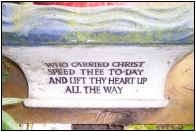
Tom Muckley, September 2005
This article was originally
published by the
Petersfield Post
tommuckley.co.uk
|
|






